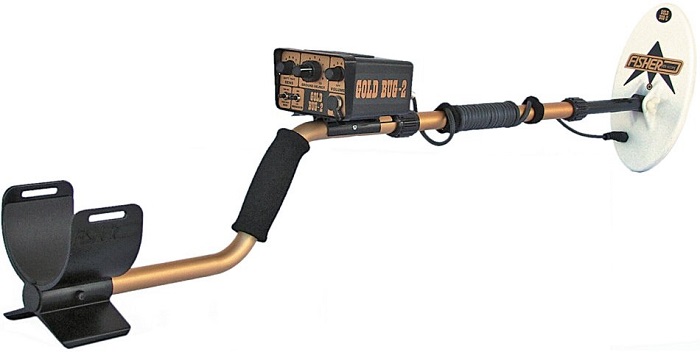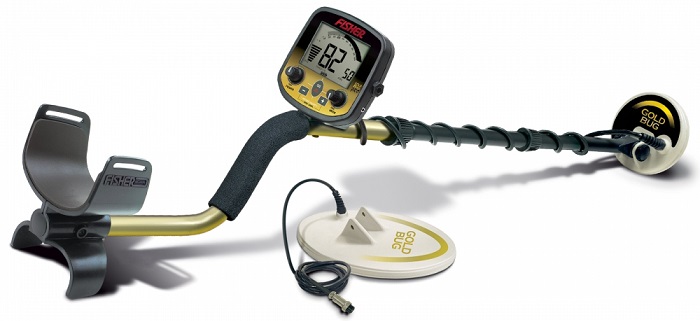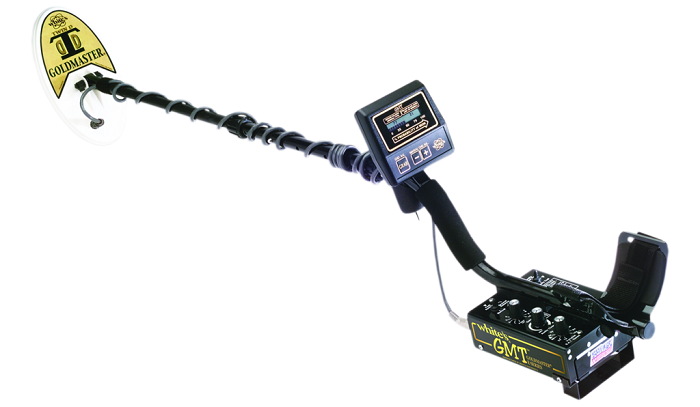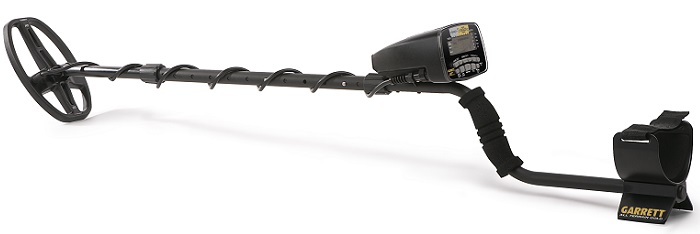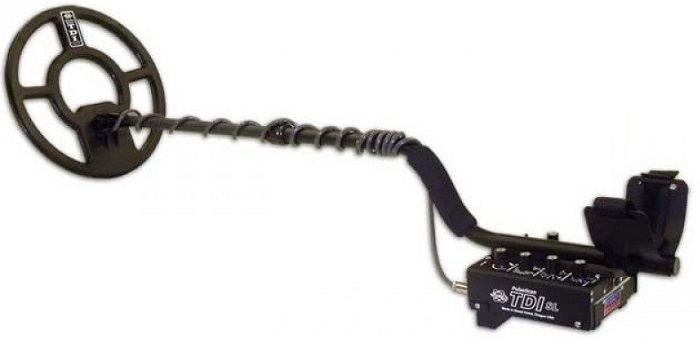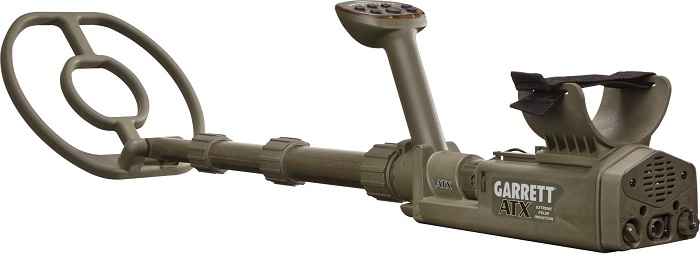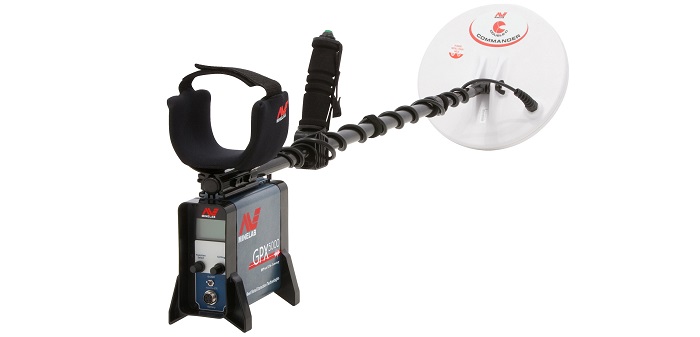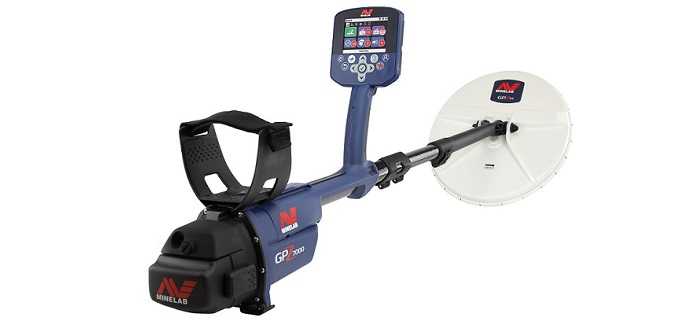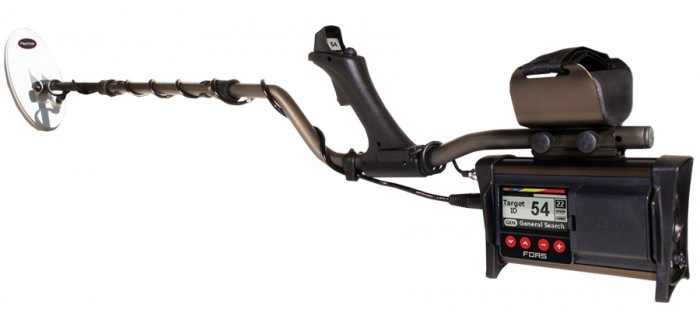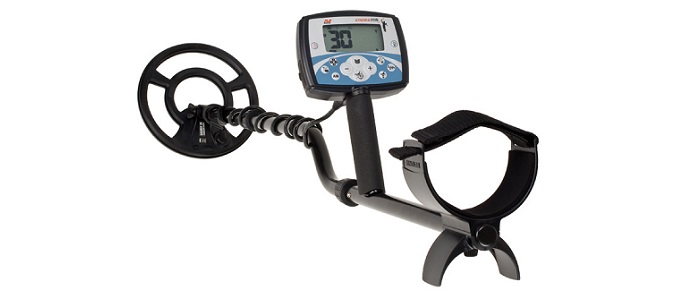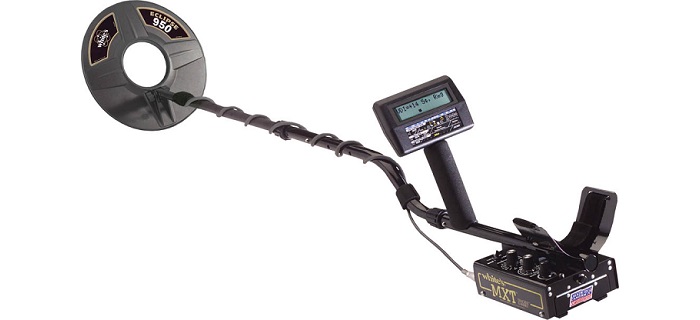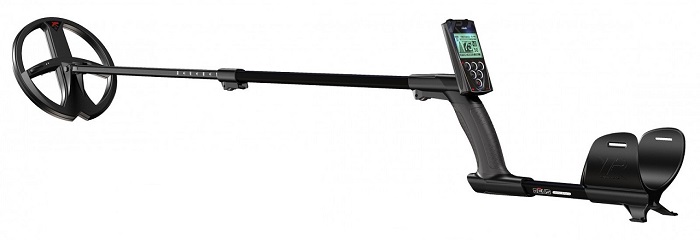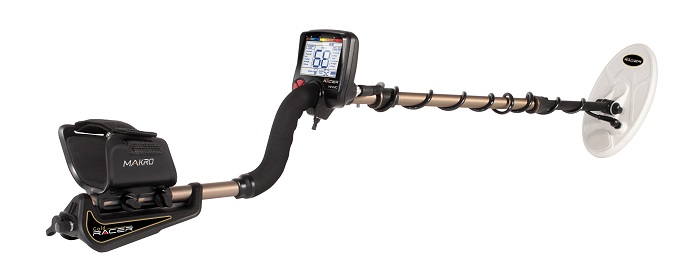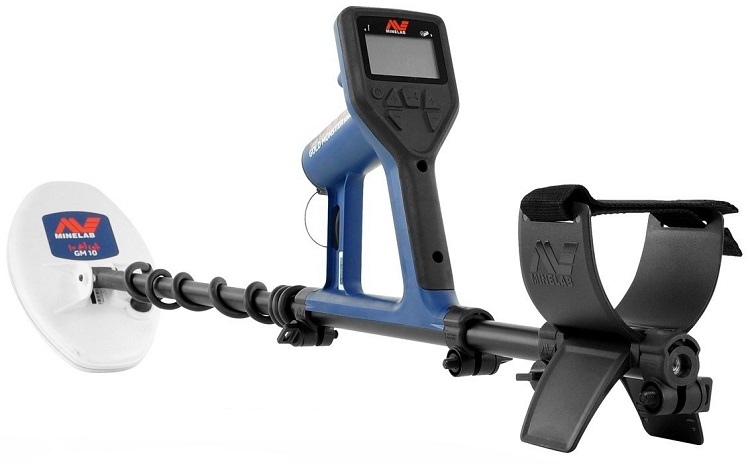I have included additional information with links to specific articles about some of these detectors, so be sure to explore further if you are looking for additional information on these detectors.
1.Fisher Gold Bug 2
I would go so far to say that the Gold Bug 2 is the most popular gold metal detector of all time, at least for finding gold nuggets. It has been on the market for over 20 years now, yet it is still the go-to detector for many prospectors, especially in areas that that have really small gold nuggets. It is extremely sensitive, and can find tiny crumbs of gold that are so small they will hardly register on a digital scale.
One downside of the Gold Bug 2 is that its high sensitivity also makes it very sensitive to highly mineralized ground and hot rocks. There are occasions when it won’t operate will in some of the hottest ground. Of course this can be said for many other VLF detectors as well.
I think this detector still has one of the most loyal followings of any ever produced. I know lots of successful gold hunters who don’t even bother trying new detectors that come out because they’ve already got everything they need with the Gold Bug 2. And I can’t say they are wrong, because they find many ounces of gold each season using one.
The main thing I would recommend when using the Gold Bug 2 is to focus on hunting shallow bedrock areas where small gold can hide down in the cracks. This is not a detector to use for hunting deep targets. Depth is not what it is designed for. Search in those shallow areas where it is only a few inches or less down to bedrock. This is where the “bug” really shines!
Also Read: One Crumb at a Time: Gold Detecting with the Fisher Gold Bug 2
2. Fisher Gold Bug Pro
The Gold Bug Pro is the latest gold detector offered by Fisher Labs, and it does not disappoint. In fact, it is my personal VLF detector that I use when I am working shallow ground, primarily because I just like how simple and fun it is to use. It is easily one of the most simple detectors I have ever used and with very little experience I feel that a beginner could start finding gold in no time using this detector.
Read: Quick Tips and Settings for the Gold Bug Pro
It will not detect at great depths like the pulse induction detectors will, but it handles hot ground very well for a VLF detector, and it has an accurate discrimination. This is another reason that I enjoy using the Gold Bug Pro; it works very well in trashy areas where you want to avoid iron rubbish. I still use it in all-metal mode, but by reading the target IDs on the LCD screen I can determine whether or not I want to dig the target.
One
tip for using this detector is to get the optional 5″
x 10″ DD coil.
This coil stays on my detector all the time. It is extremely
sensitive and the ideal shape for searching on bedrock and around
brush and trees.
Also Read: Fisher Gold Bug, Gold Bug Pro, and Gold Bug DP. What’s the difference?
3. White GMT
White’s make high quality detectors, and the GMT is certainly a popular one. There is a loyal following of nugget shooters who even prefer the GMT to the Gold Bug 2. No doubt about it, it’s a sensitive gold detector that will find small crumbs of gold.
The GMT has automatic tracking, meaning that it reads the ground conditions as you are detecting and adjusts itself to the current conditions.
In many ways the White’s GMT is very similar to the Fisher Gold Bug 2. Both have been on the market for many years now, yet they are easily as good as or better than all the newer detectors on the market even though they lack some of the “bells and whistles” that you get with the newer ones.
This was one of the early detectors to adopt a visual display, giving the user something else to determine whether the target should be dug or not. I know a lot of old-timers rely totally on sound to determine whether a target should be dug, but I personally like a visual display. Particularly in those trashy locations where you just can’t dig all the targets, it is really nice to be able to get a better understanding of what is under the ground.
Also Read: The White’s GMT: A Specialized Gold Detector
4. Tesoro Lobo SuperTRAQ
The SuperTRAQ is an “oldie but goodie” of gold detectors. It is extremely simple to operate and works really well. As with all VLF metal detectors, it can be challenging to operate in ground with high mineralization, but in ideal conditions it can also detect those smallest gold nuggets.
The SuperTRAQ lacks a visual display, and is quite similar to the Fisher Gold Bug 2 in that respect. It is a very capable gold detector, but it operates at 17.8 kHz (compared to the 72 kHz of the GB2) so it is simply not as sensitive as the Gold Bug 2 and for that reason it seems that very few gold prospectors use it these days.
That isn’t to say that it isn’t a capable gold detector, I just don’t seem to see it in use much anymore in the goldfields.
Like the White’s GMT, the SuperTRAQ has a ground tracking feature that detects the ground changes in the soil and automatically adjusts accordingly, but again it lacks the visual display.
More: Gold Nugget Detecting with the Tesoro Lobo SuperTRAQ
5. Garrett AT Gold
The AT Gold is Garrett’s newest offering for nugget hunting. It has been one of their best sellers, and works quite well. Back in the late 2000s there was a real increased interest in gold prospecting with the quick rise of gold prices. Several companies capitalized on this, and Garrett was no exception.
If
you are looking for a gold detector with lots of features, options
and different adjustments then this is a good one. There are several
coil options that come with this detector, and it is probably one of
the best deals for a new detector on the market today. You can buy
the AT Gold as part of a
bundle package and
get some very good deals with lots of other gear and supplies if you
are a new prospector just getting started.
Another nice thing about the Garrett AT Gold is that it’s completely waterproof, so you can use it to search for gold nuggets while wading in creeks and rivers. There aren’t very many waterproof options for gold hunting detectors, so the AT Gold is one of the better options if you need to get wet.
Read: Nugget Hunting with the Garrett AT Gold
6. Whites TDI
The TDI was the first Pulse Induction metal detector that Whites ever designed, as a competitor to the highly popular series of detectors produced by Minelab. While it never gold a huge following among gold hunters, there is no doubt that it will find gold nuggets. Some prospectors use it with great success.
It is certainly not as popular as Minelab’s gold detectors, but it is also priced much more reasonably. It is the least expensive Pulse Induction detector on the market right now, making it a good option if you are looking to get a metal detector with that technology for a reasonable cost.
7. Garrett ATX
The Garrett ATX is the first gold specific pulse induction metal detector that Garrett has ever designed. As a competitor to the popular Minelab detectors, it is a good introduction the field. The PI technology allows it to punch deep on large gold nuggets making it a great choice in areas that are known to produce large gold.
One common complaint with the ATX is that it is heavy, and older users have a hard time swinging it for hours on end. It is designed on the same platform as their landmine detectors, which means that it is durable but at the same time it’s maybe a bit overkill for the average gold prospector.
The ATX
Deepseeker Package comes
with a huge 20” DD coil that is designed to punch even deeper on
those nuggets.
Perhaps the most interesting feature of the ATX is that it is waterproof up to 10 feet. It was the first waterproof PI gold detector to hit the market (soon to be followed by the Minelab SDC2300) and opened up new areas that were previously inaccessible. The waterproof feature is not only handy for submerged hunting, but also for just hunting in the rain. When you need to head back to shelter with other detectors, you can keep on hunting if you have the Garrett ATX.
Also Read: The Garrett ATX Gold Detector
And: 3 Metal Detectors for Underwater Gold Hunting
8. Minelab GPX 5000
The GPX 5000 is an awesome gold detector. Equipped with a big coil, it is still the best detector on the market for finding big gold nuggets at extreme depths. Most detectors on the market will make this claim, but the Minelab detectors can really make that claim, which is the reason that they are the main detector being used in the goldfields worldwide.
It is specifically designed to search for nuggets in ground with high iron content. This is the reason why Minelab has been so popular in Australia and the brutal ground conditions there.
The other nice thing about the GPX series of detectors is the huge variety of coil options that area available for them. Between the Commander, Nuggetfinder and Coiltek coils, there are loads of different options. I personally like to use small coils, which will still detect gold at amazingly depths if you set your detector up properly.
9. GPZ 7000
The GPZ 7000 is Minelab’s latest offering, and it is proving to be a whole new level of metal detecting technology. I feel like a dealer saying that (I’m not), but I have seen this detector in action and it is finding gold nuggets in areas that have been absolutely HAMMERED by prospectors using just about every other detector on this list.
The downside: it costs nearly $10,000… and it usually takes lots of gold nuggets to pay for a detector of that price. Still, the GPZ 7000 is a heck of a detector and is probably the best detector on the market today.
Since this metal detector is still new to the market, there is currently only one coil option (Update 2018: There is a new 19″ coil now for the GPZ7000. Most prospectors I have talked with still prefer the 14″ coil). There is already discussion of a large coil in the works, and I am sure that there will be many more options in the coming years to go along with this detector.
If you are reading this list simply looking for the “best” gold detector out there then you’re probably looking for the GPZ 7000, but it’s going to cost you.
10. Minelab SDC 2300
The SDC is a newer detector from Minelab. It is a waterproof detector and is probably the best option available if you want to hunt in the water. Unlike the Garrett ATX, it is relatively lightweight and seems to be designed more ergonomically with the user in mind.
It is equipped from the factory with a small coil, and is extremely sensitive to small gold nuggets. In fact, it is really closing the gap between VLF and PI detectors for finding those tiny bits of gold. I know several prospectors that are using the SDC 2300 in dry washes in Arizona and cleaning out the bedrock cracks with this detector.
The SDC 2300 also folds up really nice and compact, making it the perfect detector for tossing in a backpack and exploring those remote goldfields away from roads.
11. Nokta Fors Gold+
The Nokta Fors Gold is a newer detector on the market. It is actually produced in Turkey, and it seemed that people a bit hesitant to buy it because they were accustomed to buying American-made detectors. Nonetheless, this detector has begun to prove itself highly capable in finding gold.
In fact, for a VLF detector many prospectors are amazed at how well it handle iron rich grounds. It also has some interesting features that are not available on other detectors, and it is priced very competitively.
12. Minelab XTerra 705
The XTerra 705 is one of the few multi-purpose metal detectors that will ACTUALLY find gold nuggets on a consistent basis, and can handle the ground conditions that they are found in. This is something to be wary of… there are tons of cheap multi-purpose detectors on the market that are advertised to find gold, but that does not mean they are actually good gold detectors. The XTerra 705 is very capable and works beautifully for gold nugget hunting.
It
is very important that you get the proper coil for it.For gold
prospecting you want to get the 5″
x 10″ DD coil which
operates at 18.75 kHz. The other coils will not work well in the
goldfields as they run at a different frequency, so make sure you use
this coil and learn to operate it properly.
This is one of the few detectors on this list that you can successfully use for coins, relics, and gold nuggets without major sacrifices in performance.
13. Whites MXT
I have a soft spot for the MXT because it was the first high-quality metal detector that I ever purchased. At the time, I was interested in finding relics in ghost towns, so I wanted a detector that could work for both relics as well as gold nuggets. The MXT did not disappoint, although it took me a while to learn how to understand it.
If you get one for nugget hunting, I would highly recommend you get the 4×6 DD coil or the 6 x 10 DD coil. These coils will work much better in mineralized ground than the standard coils that come with it from the factory.
Along with the Xterra 705 mentioned above, the MXT is one of only a few detectors out there that is a good gold detector as well as a fine multi-purpose unit.
I have also successfully used the relic mode to hunt for gold in trashy locations with the MXT. It is a favorite for hunting around lots of iron rubbish.
More: Using the MXT to find Gold Nuggets
14. Minelab Eureka Gold
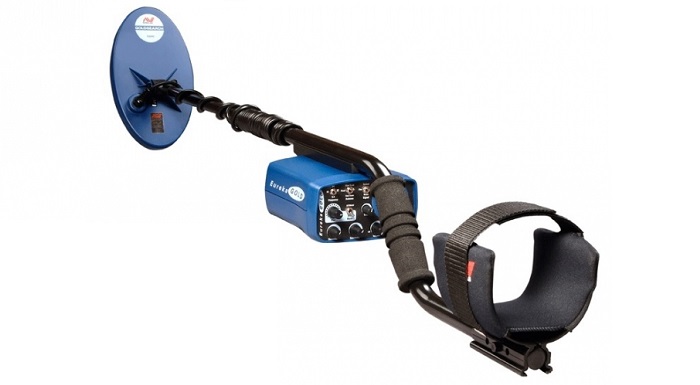
*NOTE: Production of the Eureka Gold was discontinued with the release of the Gold Monster 1000
The Eureka Gold has been on the market for a long time, and it is a capable gold detector, although honestly most of the other detectors on this list are better choices than the Eureka. I know a lot of gold prospectors, and I can’t think of one who is actively using the Eureka Gold today.
That isn’t to say that it’s not a decent gold detector, and it certainly deserves a spot on this list. It is still a better detector for gold nuggets than most detectors on the market today, but I probably wouldn’t recommend it compared to most of the other detectors on this list. Still, it is worth a mention. If you’ve got one collecting dust in your closet I wouldn’t hesitate to take it out and use it.
15. XP DEUS
The XP DEUS is another detector that is relatively new to the market. It is a VLF detector, and it gained its reputation not in the goldfields but in the old mining camps and fields in Europe. It has exceptional target separation that can pick out the sweet targets from the iron rubbish. In this regard, it surpasses most other detectors on the market. But how does it fair as a gold detector?
Well, anyone who has spent any time in gold country knows that certain areas contain an exceptional amount of trash. And as much as we like to say that we will dig all targets, some areas are so nasty that we simply walk past them, even though we know that there are nuggets in there. This is where the XP DEUS really shines as a gold detector. If you hunt in trashy areas this is a great little detector. Additionally it is totally wireless, which a neat feature is.
With the newest software upgrade there is now a Goldfield Program that is specifically for gold prospecting.
More details about the features of the XP DEUS can be found in this article:
Hunting for Gold Nuggets with the XP DEUS
16. Makro Gold Racer (new addition to list. Summer, 2016)
With the prospecting season in full swing here in the northern part of the U.S., I have had the pleasure of getting to use a new gold detector that has hit the market; the Makro Gold Racer.
The Gold Racer operates at 56 kHz, so it is extremely sensitive to small gold very similar to the Gold Bug 2. I have used it with both the 5”x 10” DD coil and the 13” x 15” DD coil, and while both have their place I have found the smaller of the two to be quite a bit more sensitive. It also comes with a small 5” round coil, but I don’t particularly like that shape of coils and I much prefer to use the ellipticals.
It didn’t take me long to realize that the Makro Gold Racer deserves a spot on this list as well. I intend to use this detector quite a bit this coming season.
More: Nugget Hunting with the Makro Gold Racer
17. Minelab Gold Monster 1000 (new addition to list. Summer, 2017)
The newest gold detector to hit the market is the Minelab Gold Monster 1000. In my opinion, this detector is long overdue. Minelab is the leader in pulse induction detector technology, yet their VLF options were outdated and limited.
The new Gold Monster uses technology that is very different from previous detectors. It has been designed for sensitivity to small gold, and also general usability.
Early reports on this detector have been extremely positive. This detector does not have a threshold, which is different from other VLF detectors. Field testers are reporting that this detector has an impressive ability to discriminate out hot rocks that general give fits to other detectors.
More: A New Gold Detector! The Minelab Gold Monster 1000
The Best Gold Detectors Today
The metal detectors we listed above are all available and can be purchased on the market today. There are certainly others that were manufactured years ago that are still very capable of finding gold nuggets.
Yet, generally the newer technology will have advances that makes them better than their predecessors. There will certainly be some that disagree, but some of the newer detectors that have come out in recent years are some of the best that we have ever seen. The detectors on this list are all highly capable at finding gold nuggets under a variety of situations.
Still, remember that those gold nuggets do not find themselves. You have to get out there and swing your coil over top of a nugget if you actually hope to find one.
Have fun in the goldfields!
